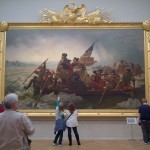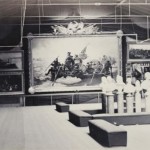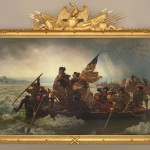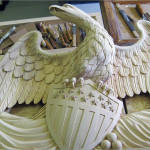Wandering around the vast Metropolitan Museum of Art in New York the other day, I found myself in front of a famous American painting I hadn’t seen in a number of years: Washington Crossing the Delaware, an enormous historical canvas created in 1851 by the German-born artist Emanuel Leutze. Measuring 21 feet wide and 12 feet high, the life-size composition is one of the most instantly recognizable and beloved images in our nation’s art. The painting’s impact has been further enhanced by the elaborate new hardwood frame it acquired in 2012. I had not seen this absolutely stunning masterpiece of the woodcarver and gilder’s art before, so I decided to do some research on it.

Emanuel Gottlieb Leutze’s 1851 Washington Crossing the Delaware, one of the most visited paintings in New York’s Metropolitan Museum of Art, was given a splendid new hand-carved hardwood frame in 2012.
Washington Crossing the Delaware was a smash hit right from its first public presentation in New York City in 1851. Sold to a private collector, it created another sensation in April 1864 as part of the Metropolitan Sanitary Fair benefitting Union soldiers. On that occasion, legendary Civil War photographer Mathew Brady captured the painting in its original frame, a dramatic gilded affair dominated by a 12-foot-wide American-eagle crest at the top. Designed by Leutze, it was precisely the right frame for the painting with a graceful grandeur and abundance of carved symbols—the eagle, gathered flags, crossed cannons, pikes, shields, bayonets, ribbons—that spoke to George Washington and the hopes and aspirations of the then-young nation.

Famed Civil War documentarian Mathew Brady photographed Washington Crossing the Delaware in its original frame in April 1864, when the painting was exhibited at the Metropolitan Sanitary Fair in aid of Union soldiers.
But by the time Leutze’s painting was donated to the Met in 1897, it had been reframed in a less ornate style; a few years later it acquired an even plainer frame in the belief that this allowed the viewer to focus on the painting alone. But fashions change, and there is a growing movement to reunite paintings with period-appropriate frames. So when the Met’s magnificent American Wing emerged from a decade-long renovation in 2012, its most famous work was given the gorgeous new frame I saw this summer—a painstaking recreation of the original based on Brady’s 150-year-old photograph.

The new basswood frame, hand carved and gilded by Eli Wilner & Company, is a meticulous recreation of the original based on Mathew Brady’s photograph of the painting from 1864.
The new frame was made by Eli Wilner & Company, New York-based specialists in sourcing, conserving, and replicating American and European frames from the 17th through mid-20th centuries. The company’s impressive array of framing jobs includes projects for the White House, the Smithsonian Institution, and auction house Christie’s. Working in Wilner’s Long Island City atelier, master woodcarver Félix Terán reproduced the frame’s 12-foot-long high-relief center crest in basswood, an American hardwood that’s not only easy to carve but also stable in heat and humidity, making it an ideal choice for such a large structure.

The frame’s imposing American eagle center crest with its shield, draped flags, and other patriotic symbols was hand carved in basswood by master carver Félix Terán, who comes from a family of woodcarvers in San Antonio de Ibarra, Ecuador.
A 12-member Wilner crew worked full-time for more than a year on the massive project. Over 12,500 3½-inch squares of gold leaf were used to gild the carved frame, which weighs a hulking 3,000 pounds and was made to disassemble for transport to the museum. The renovated American Wing affords a dramatic vista toward Washington Crossing the Delaware and its breathtaking new frame. The double-sized gallery showcases Leutze’s iconic work near two other masterpieces—Church’s Heart of the Andes and Albert Bierstadt’s Rocky Mountains—just as they were displayed back in 1864 at the Metropolitan Sanitary Fair.



